Observed Correlation between Aerosol and Cloud Base Height for Low Clouds at Baltimore and New York, United States
Abstract
1. Introduction
2. Data
3. Results and Discussion
4. Conclusions
Acknowledgments
Author Contributions
Conflicts of Interest
References
- Intergovernmental Panel on Climate Change (IPCC). Climate Change 2013: The Physical Science Basis. Contribution of Working Group I to the Fifth Assessment Report of the Intergovernmental Panel on Climate Change; Stocker, T.F., Qin, D., Plattner, G.-K., Tignor, M., Allen, S.K., Boschung, J., Nauels, A., Xia, Y., Bex, V., Midgley, P.M., Eds.; Cambridge University Press: Cambridge, UK, 2013. [Google Scholar] [CrossRef]
- Twomey, S. Pollution and the planetary albedo. Atmos. Environ. 1974, 8, 1251–1256. [Google Scholar] [CrossRef]
- Albrecht, B.A. Aerosol, cloud microphysics, and fractional cloudiness. Science 1989, 245, 1227–1230. [Google Scholar] [CrossRef] [PubMed]
- Han, Q.; Rossow, W.B.; Chou, J.; Welch, R.M. Global variation of cloud effective droplet concentration of low-level clouds. Geophys. Res. Lett. 1998, 25, 1419–1422. [Google Scholar] [CrossRef]
- Wang, T.; Wang, H.J.; Otterå, O.H.; Gao, Y.Q.; Suo, L.L.; Furevik, T.; Yu, L. Anthropogenic agent implicated as a prime driver of shift in precipitation in eastern China in the late 1970s. Atmos. Chem. Phys. 2013, 13, 12433–12450. [Google Scholar] [CrossRef]
- Pan, Z.; Gong, W.; Mao, F.; Li, J.; Wang, W.; Li, C.; Min, Q. Macrophysical and optical properties of clouds over East Asia measured by CALIPSO. J. Geophys. Res. Atmos. 2015, 120. [Google Scholar] [CrossRef]
- Pan, Z.; Mao, F.; Gong, W.; Wang, W.; Yang, J. Observation of clouds macrophysical characteristics in China by CALIPSO. J. Appl. Remote Sens. 2016, 10. [Google Scholar] [CrossRef]
- Rosenfeld, D.; Sherwood, S.; Wood, R.; Donner, L. Climate effects of aerosol-cloud interactions. Science 2014, 343, 379–380. [Google Scholar] [CrossRef] [PubMed]
- Feingold, G.; Eberhard, W.; Veron, D.; Previdi, M. First measurements of the Twomey indirect effect using ground-based remote sensors. Geophys. Res. Lett. 2003, 30, 1287. [Google Scholar] [CrossRef]
- Huang, J.-P.; Wang, T.; Wang, W.; Li, Z.; Yan, H. Climate effects of dust aerosols over East Asian arid and semiarid regions. J. Geophys. Res. Atmos. 2014, 119, 11398–11416. [Google Scholar] [CrossRef]
- Kim, B.G.; Schwartz, S.E.; Miller, M.A.; Min, Q. Effective radius of cloud droplets by ground-based remote sensing: Relationship to aerosol. J. Geophys. Res. 2003, 108, 4740. [Google Scholar] [CrossRef]
- Kim, B.G.; Miller, M.A.; Schwartz, S.E.; Liu, Y.; Min, Q. The role of adiabaticity in the aerosol first indirect effect. J. Geophys. Res. 2008, 113, D05210. [Google Scholar] [CrossRef]
- Kim, Y.; Kim, B.; Miller, M.; Min, Q.; Song, C. Enhanced aerosol-cloud relationships in more stable and adiabatic clouds. Asia-Pac. J. Atmos. Sci. 2012, 48, 283–293. [Google Scholar] [CrossRef]
- Li, Z.; Niu, F.; Fan, J.; Liu, Y.; Rosenfeld, D.; Ding, Y. Long-term impacts of aerosols on the vertical development of clouds and precipitation. Nat. Geosci. 2010, 4, 888–894. [Google Scholar] [CrossRef]
- Li, S.; Joseph, E.; Min, Q.; Yin, B. Multi-year ground-based observations of aerosol-cloud interactions in the Mid-Atlantic of the United States. J. Quant. Spectrosc. Radiat. Transf. 2017, 188, 192–199. [Google Scholar] [CrossRef]
- Pan, Z.; Mao, F.; Gong, W.; Min, Q.; Wang, W. The Warming of Tibetan Plateau Enhanced by 3D Variation of Low-level Clouds during Daytime. Remote Sens. Environ. 2017, 198, 363–368. [Google Scholar] [CrossRef]
- Mao, F.; Min, Q.; Liu, G.; Feng, S.; Jin, S.; Hu, J.; Gong, W.; Li, C. Assimilating moderate resolution imaging spectroradiometer radiance with the weather research and forecasting data assimilation system. J. Appl. Remote Sens. 2017, 11. [Google Scholar] [CrossRef]
- Ellrod, G.P.; Gultepe, I. Inferring low cloud base heights at night for aviation using satellite infrared and surface temperature data. Pure Appl. Geophys. 2007, 164, 1193–1205. [Google Scholar] [CrossRef]
- Mittermaier, M. A critical assessment of surface cloud observations and their use for verifying cloud forecasts. Q. J. R. Meteorol. Soc. 2012, 138, 1794–1807. [Google Scholar] [CrossRef]
- Vislocky, R.L.; Fritsch, J.M. An automated, observations-based system for short-term prediction of ceiling and visibility. Weather Forecast. 1997, 12, 31–43. [Google Scholar] [CrossRef]
- Gryspeerdt, E.; Stier, P.; Grandey, B.S. Cloud fraction mediates the aerosol optical depth-cloud top height relationship. Geophys. Res. Lett. 2014, 44, 3622–3627. [Google Scholar] [CrossRef]
- Stevens, B.; Feingold, G. Untangling aerosol effects on clouds and precipitation in a buffered system. Nature 2009, 461, 607–613. [Google Scholar] [CrossRef] [PubMed]
- Koren, I.; Kaufman, Y.J.; Rosenfeld, D.; Remer, L.A.; Rudich, Y. Aerosol invigoration and restructuring of Atlantic convective clouds. Geophys. Res. Lett. 2005, 32, 10–1029. [Google Scholar] [CrossRef]
- Koren, I.; Remer, L.A.; Altaratz, O.; Martins, J.V. Aerosol-induced changes of convective cloud anvils produce strong climate warming. Atmos. Chem. Phys. 2010, 10, 5001–5010. [Google Scholar] [CrossRef]
- Kourtidis, K.; Stathopoulos, S.; Georgoulias, A.K.; Alexandri, G.; Rapsomanikis, S. A study of the impact of synoptic weather conditions and water vapor on aerosol–cloud relationships over major urban clusters of China. Atmos. Chem. Phys. 2015, 15, 10955–10964. [Google Scholar] [CrossRef]
- An, N.; Wang, K.C.; Zhou, C.L.; Pinker, R.T. Observed variability of cloud frequency and cloud-base height within 3600 m above the surface over the contiguous United States. J. Clim. 2017, 30, 3725–3742. [Google Scholar] [CrossRef]
- Costa-Surós, M.; Calbó, J.; González, J.; Long, C.N. Comparing the cloud vertical structure derived from several methods based on radiosonde profiles and ground-based remote sensing measurements. Atmos. Meas. Tech. 2014, 7, 2757–2773. [Google Scholar] [CrossRef]
- Chernykh, I.V.; Alduchov, O.A.; Eskridge, R.E. Trends in low and high cloud boundaries and errors in height determination of cloud boundaries. Bull. Am. Meteorol. Soc. 2001, 82, 1941–1947. [Google Scholar] [CrossRef]
- Minnis, P.; Yi, Y.; Huang, J.; Ayers, K. Relationships between radiosonde and RUC-2 meteorological conditions and cloud occurrence determined from ARM data. J. Geophys. Res. 2005, 110, D23204. [Google Scholar] [CrossRef]
- Wang, J.; Rossow, W.B. Determination of cloud vertical structure from upper-air observations. J. Appl. Meteorol. 1995, 34, 2243–2258. [Google Scholar] [CrossRef]
- Zhang, J.; Chen, H.; Bian, J.; Xuan, Y.; Duan, Y.; Cribb, M. Development of cloud detection methods using CFH, GTS1, and RS80 radiosondes. Adv. Atmos. Sci. 2012, 29, 236–248. [Google Scholar] [CrossRef]
- Li, S. Aerosol indirect effect and cloud-based height observations in the North East of the United States. Int. J. Earth Environ. Sci. 2017, 2, 128. [Google Scholar] [CrossRef]
- Smith, A.; Lott, N.; Vose, R. The Integrated Surface Database: Recent Developments and Partnerships. Bull. Am. Meteorol. Soc. 2011, 92, 704–708. [Google Scholar] [CrossRef]
- Del Greco, S.A.; Lott, J.N.; Ray, R.; Dellinger, D.; Smith, F.; Jones, P. Surface data processing and integration at NOAA’s National Climatic Data Center. In Proceedings of the 23rd Conference on Interactive Information Processing Systems for Meteorology, Oceanography, and Hydrology (IIPS), San Antonio, TX, USA, 14–18 January 2007; American Meteorological Society: Boston, MA, USA, 2007; p. 116367. [Google Scholar]
- Vaisala. Technical Manual: Laser Ceilometer CT12K; Vaisala Report; Vaisala: Vantaa, Finland, 1989; p. 304. [Google Scholar]
- Office of the Federal Coordinator for Meteorology (OFCM). Surface Weather Observations and Reports; Federal Meteorological Handbook, No. 1; OFCM: Silver Spring, MD, USA, 1982; p. 82.
- Noble, C.A.; Vanderpool, R.W.; Peters, T.M.; McElroy, F.F.; Gemmill, D.B.; Wiener, R.W. Federal reference and equivalent methods for measuring fine particulate matter. Aerosol. Sci. Technol. 2001, 34, 457–464. [Google Scholar] [CrossRef]
- Cusworth, D.H.; Mickley, L.J.; Leibensperger, E.M.; Iacono, M.J. Aerosol trends as a potential driver of regional climate in the central United States: Evidence from observations. Atmos. Chem. Phys. 2017, 17, 13559–13572. [Google Scholar] [CrossRef]
- Craven, J.P.; Jewell, R.E.; Brooks, H.E. Comparison between observed convective cloud-base heights and lifting condensation level for two different lifted parcels. Weather Forecast. 2002, 17, 885–890. [Google Scholar] [CrossRef]
- United States Environmental Protection Agency. EPA: Lists of Potential Control Measures for PM2.5 and Precursors; Draft Version1.0; U.S. Environmental Protection Agency, Office of Air Quality Planning and Standards, Office of Transportation and Air Quality, Office of Atmospheric Programs, and Office of Policy Analysis and Review: Washington, DC, USA, 2007.
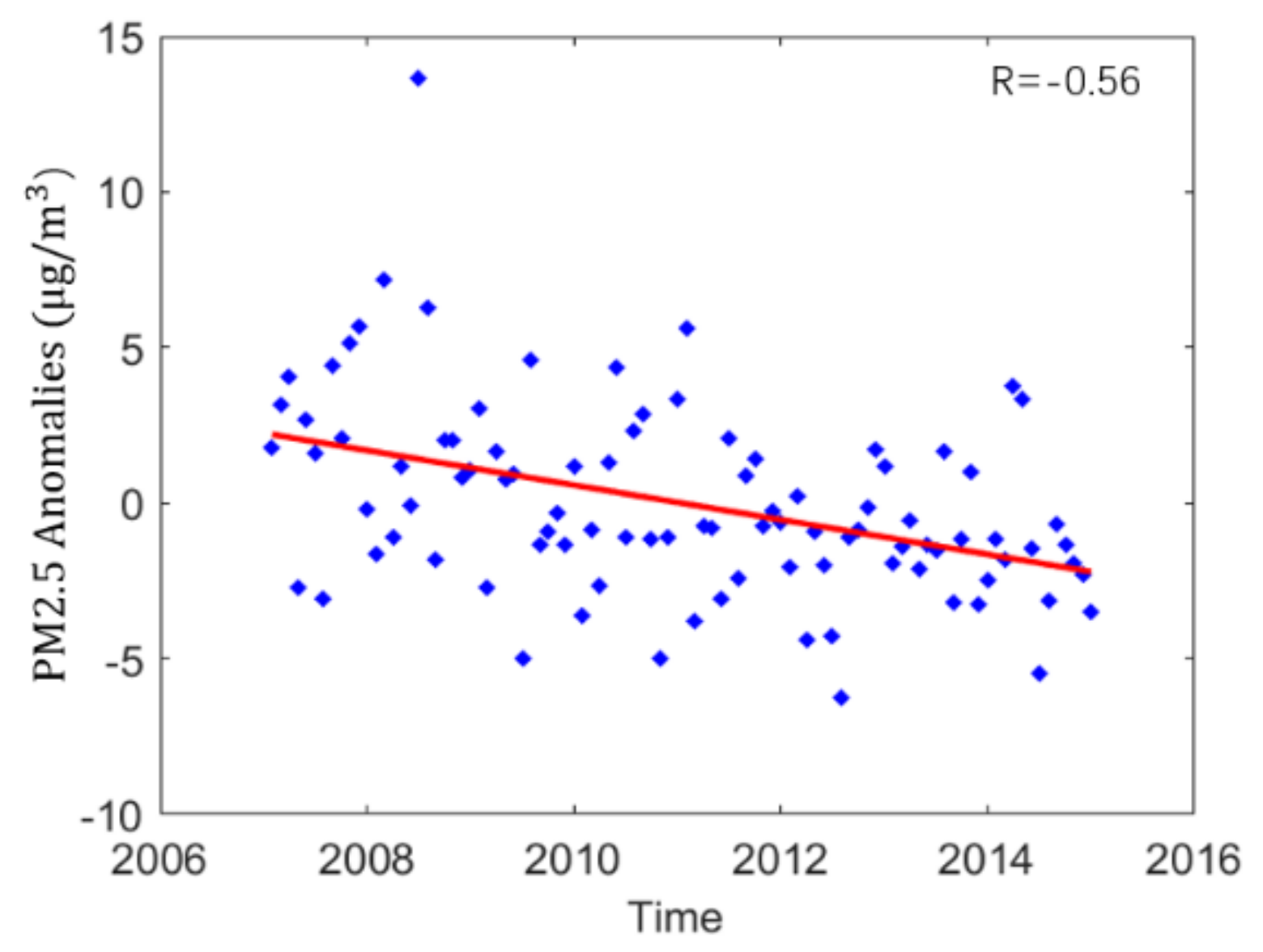

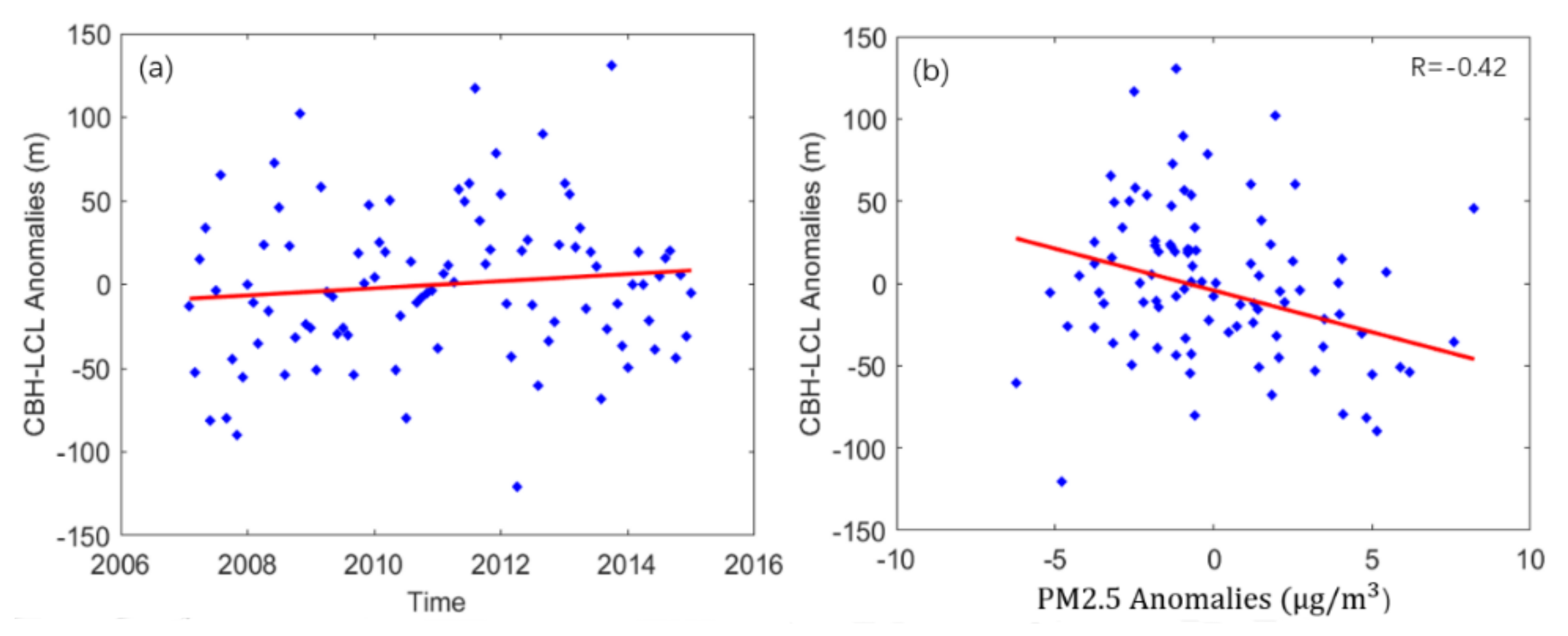
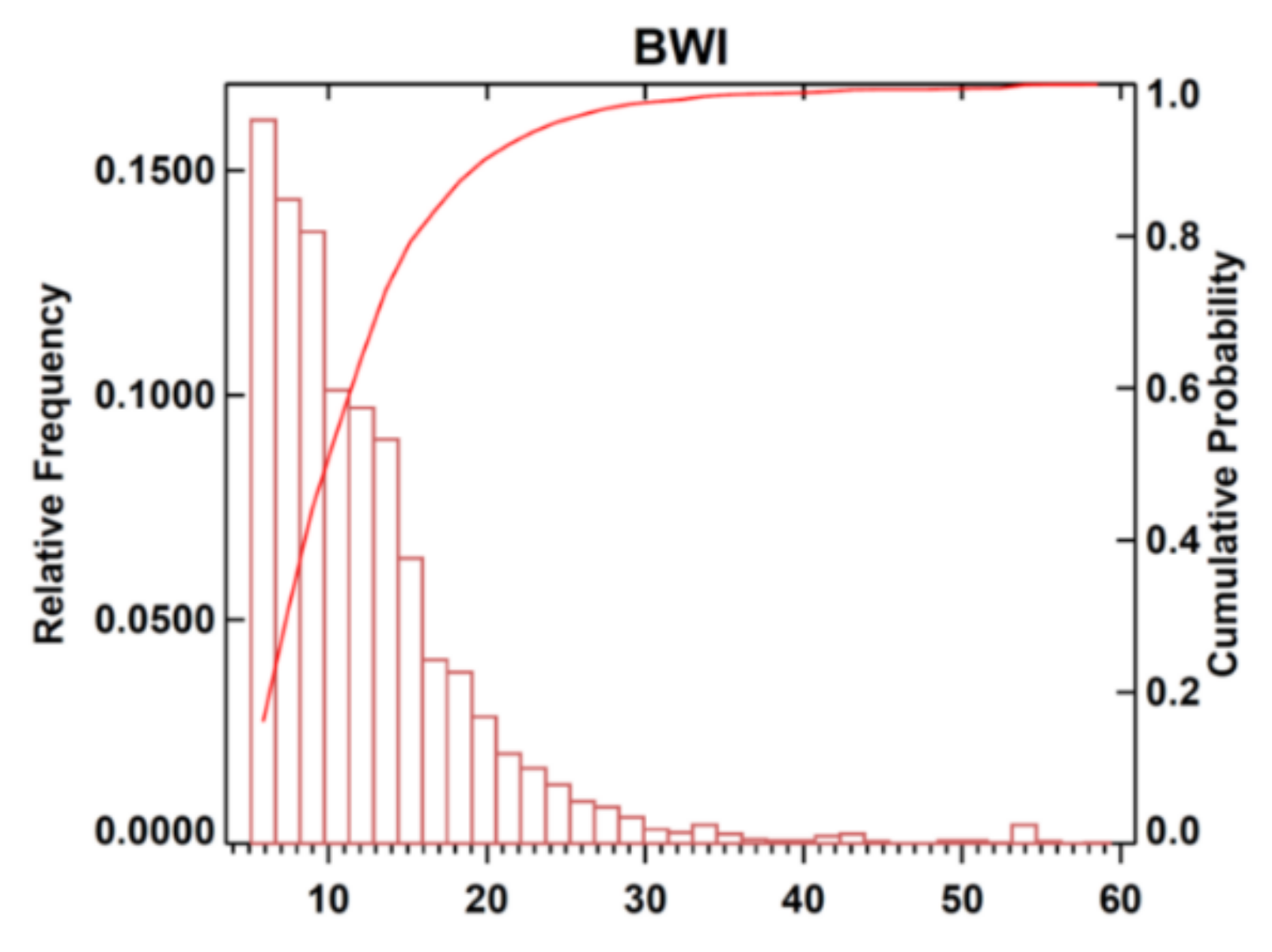

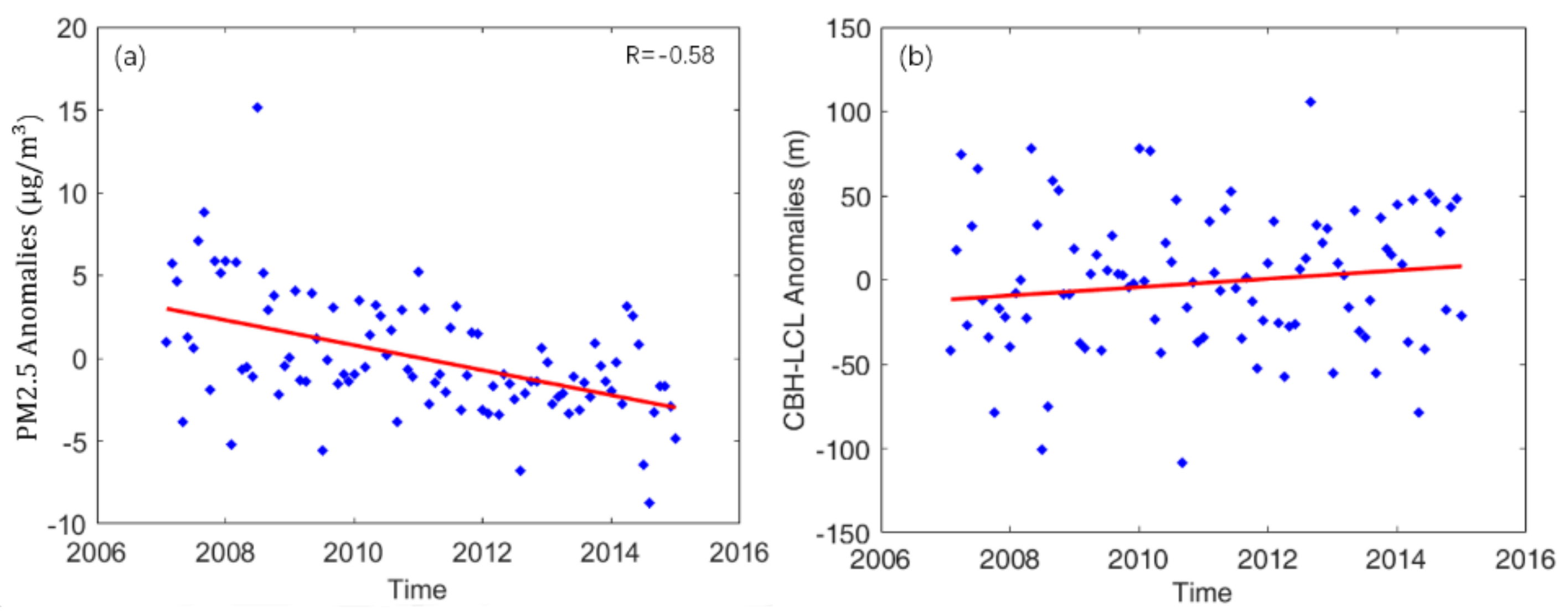
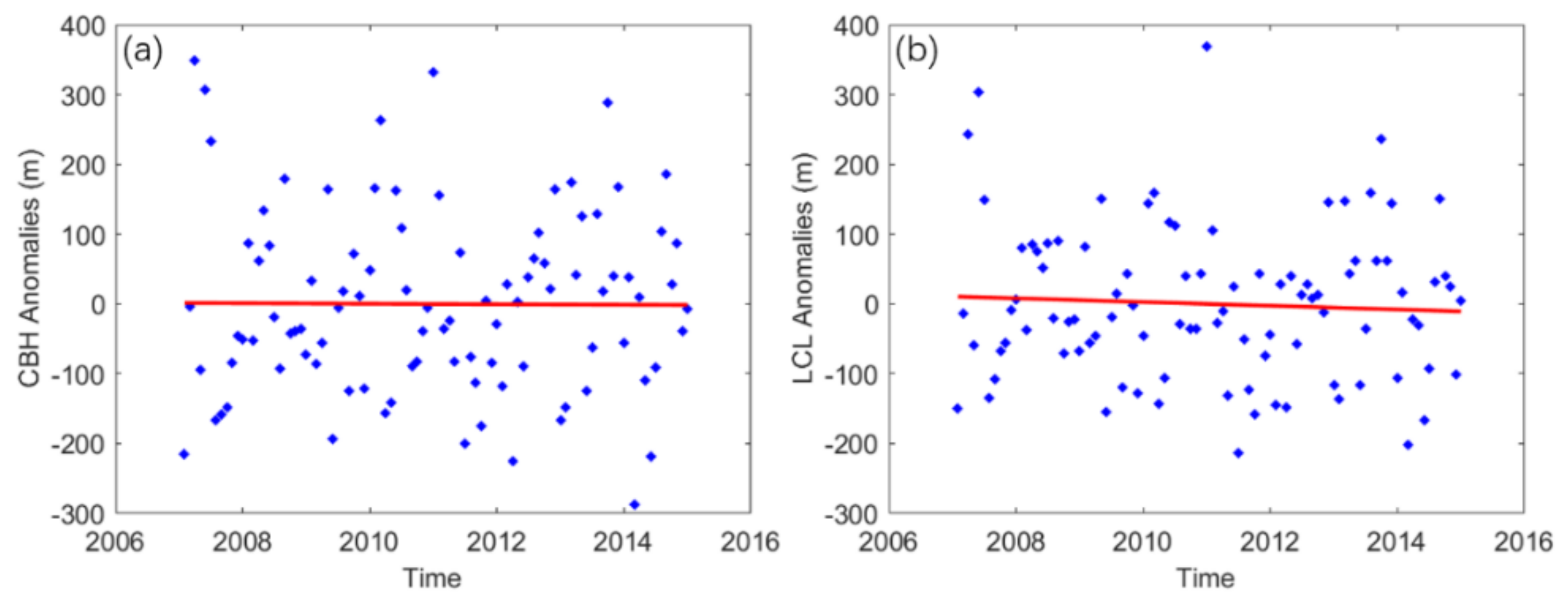
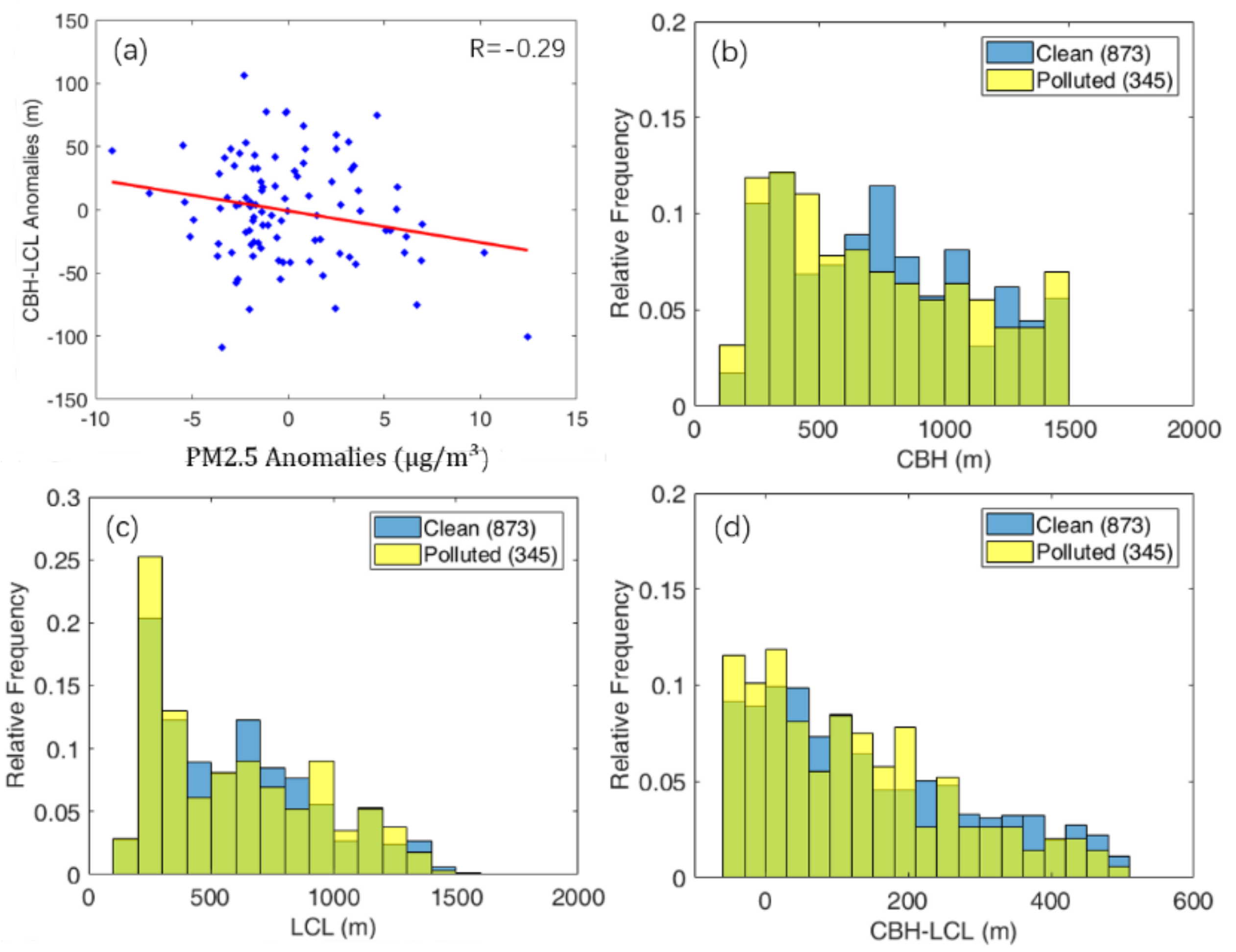
© 2018 by the authors. Licensee MDPI, Basel, Switzerland. This article is an open access article distributed under the terms and conditions of the Creative Commons Attribution (CC BY) license (http://creativecommons.org/licenses/by/4.0/).
Share and Cite
Gebremariam, S.; Li, S.; Weldegaber, M. Observed Correlation between Aerosol and Cloud Base Height for Low Clouds at Baltimore and New York, United States. Atmosphere 2018, 9, 143. https://doi.org/10.3390/atmos9040143
Gebremariam S, Li S, Weldegaber M. Observed Correlation between Aerosol and Cloud Base Height for Low Clouds at Baltimore and New York, United States. Atmosphere. 2018; 9(4):143. https://doi.org/10.3390/atmos9040143
Chicago/Turabian StyleGebremariam, Sium, Siwei Li, and Mengsteab Weldegaber. 2018. "Observed Correlation between Aerosol and Cloud Base Height for Low Clouds at Baltimore and New York, United States" Atmosphere 9, no. 4: 143. https://doi.org/10.3390/atmos9040143
APA StyleGebremariam, S., Li, S., & Weldegaber, M. (2018). Observed Correlation between Aerosol and Cloud Base Height for Low Clouds at Baltimore and New York, United States. Atmosphere, 9(4), 143. https://doi.org/10.3390/atmos9040143



